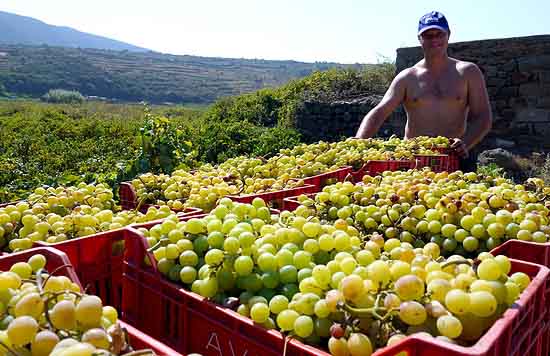 It’s a delight to learn that the United Nations has honored the grape growers of Pantelleria, naming the island’s viticultural technique part of the UNESCO Intangible Cultural Heritage of Humanity. And here I thought it was merely heroic. That’s what the Pantellerians themselves call it.
It’s a delight to learn that the United Nations has honored the grape growers of Pantelleria, naming the island’s viticultural technique part of the UNESCO Intangible Cultural Heritage of Humanity. And here I thought it was merely heroic. That’s what the Pantellerians themselves call it.
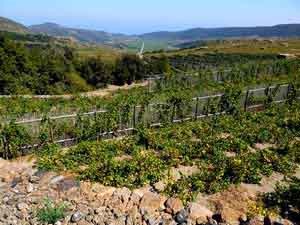 About halfway between Sicily and Tunisia, the rocky island of volcanic origins is arid and scoured by ferocious winter winds that stunt even the olive trees. Typically, houses are cut into the rock to provide protection from the wind and the blistering sun. The grapes are grown on “head trained bush vines” (vite ad alberello, in Italian). Each one is planted in a depression and trained in a low, broad bush system with two to four branches. Vines are typically 100 years old at minimum, and the vineyards are terraced inside rock walls, as if each area was a cellar hole. Maintenance is minimal, as the winds tend to keep the vines pruned. Picking is all done by hand.
About halfway between Sicily and Tunisia, the rocky island of volcanic origins is arid and scoured by ferocious winter winds that stunt even the olive trees. Typically, houses are cut into the rock to provide protection from the wind and the blistering sun. The grapes are grown on “head trained bush vines” (vite ad alberello, in Italian). Each one is planted in a depression and trained in a low, broad bush system with two to four branches. Vines are typically 100 years old at minimum, and the vineyards are terraced inside rock walls, as if each area was a cellar hole. Maintenance is minimal, as the winds tend to keep the vines pruned. Picking is all done by hand.
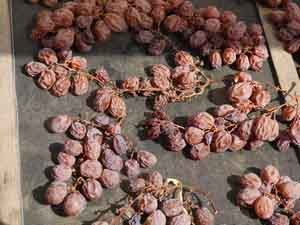 The main grape grown on Pantelleria is known locally by its Arabic moniker, Zibibbo. Genetically, it is the ancient Muscat of Alexandria—considered one of the oldest genetically unmodified grape varieties in existence. Tradition holds that Cleopatra drank wine made from it. One of the world’s great aromatic wine grapes, this strain of Muscat is found all around the Mediterranean rim.
The main grape grown on Pantelleria is known locally by its Arabic moniker, Zibibbo. Genetically, it is the ancient Muscat of Alexandria—considered one of the oldest genetically unmodified grape varieties in existence. Tradition holds that Cleopatra drank wine made from it. One of the world’s great aromatic wine grapes, this strain of Muscat is found all around the Mediterranean rim.
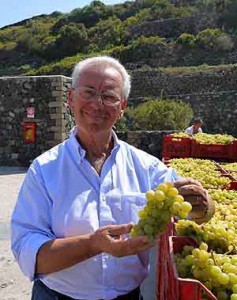 Pantellerian viticulture is the model of small-plot vineyards. Of the island’s population of 7,679, about 5,000 inhabitants own a plot of land where they cultivate Zibibbo in the traditional way, handing down the techniques from generation to generation. The old vines produce grapes that achieve powerful sugar and acid levels as well as a spicy aromatic quality lacking in a lot of hot-weather Muscat. Although Zibibbo is a tasty table grape (albeit with a tough skin and big pips), most of the harvest is dried on screens to concentrate sugar and acid before being pressed to make a sweet passito wine.
Pantellerian viticulture is the model of small-plot vineyards. Of the island’s population of 7,679, about 5,000 inhabitants own a plot of land where they cultivate Zibibbo in the traditional way, handing down the techniques from generation to generation. The old vines produce grapes that achieve powerful sugar and acid levels as well as a spicy aromatic quality lacking in a lot of hot-weather Muscat. Although Zibibbo is a tasty table grape (albeit with a tough skin and big pips), most of the harvest is dried on screens to concentrate sugar and acid before being pressed to make a sweet passito wine.
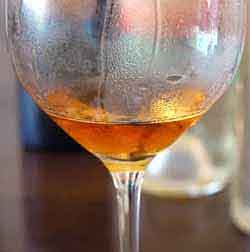 The Khamma winery, owned by the Rallo family of Donnafugata (that’s Antonio Rallo above holding a cluster of grapes), handles the lion’s share of the island’s harvest, drying and pressing each region’s grapes separately to create a final blend for Donnafugata’s Ben Ryé, possibly one of the greatest Muscat wines in the world.
The Khamma winery, owned by the Rallo family of Donnafugata (that’s Antonio Rallo above holding a cluster of grapes), handles the lion’s share of the island’s harvest, drying and pressing each region’s grapes separately to create a final blend for Donnafugata’s Ben Ryé, possibly one of the greatest Muscat wines in the world.
